Hyundai H-1 (Grand Starex) 2009 Owner's Manual - RHD (UK, Australia)
Manufacturer: HYUNDAI, Model Year: 2009, Model line: H-1 (Grand Starex), Model: Hyundai H-1 (Grand Starex) 2009Pages: 303, PDF Size: 31.48 MB
Page 281 of 303
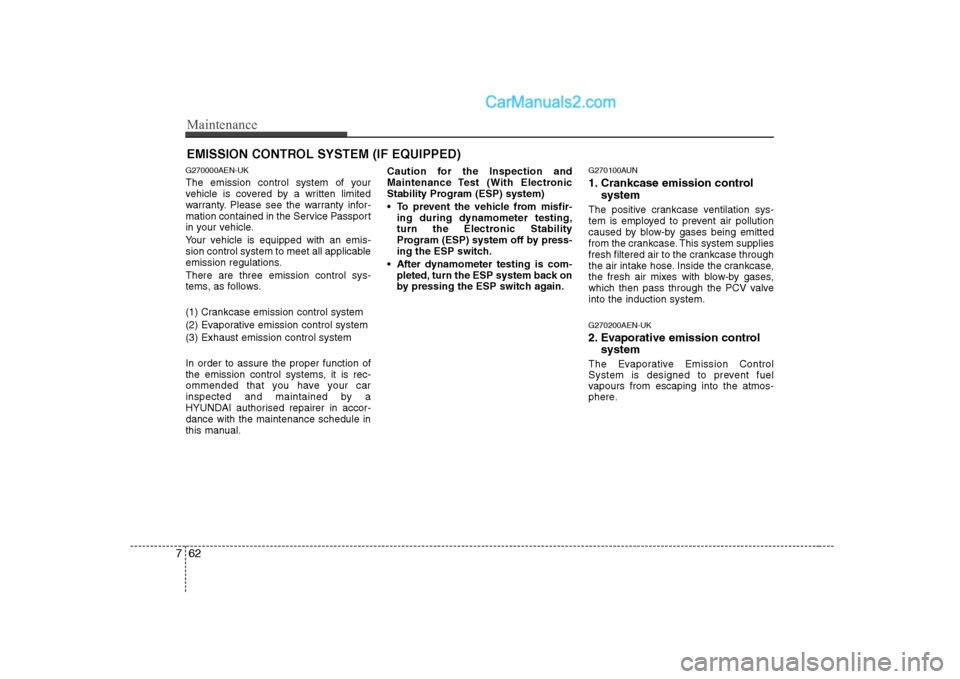
Maintenance
62
7
EMISSION CONTROL SYSTEM (IF EQUIPPED)
G270000AEN-UK
The emission control system of your
vehicle is covered by a written limited
warranty. Please see the warranty infor-
mation contained in the Service Passport
in your vehicle.
Your vehicle is equipped with an emis-
sion control system to meet all applicable
emission regulations. There are three emission control sys-
tems, as follows.
(1) Crankcase emission control system
(2) Evaporative emission control system(3) Exhaust emission control system In order to assure the proper function of
the emission control systems, it is rec-
ommended that you have your car
inspected and maintained by a
HYUNDAI authorised repairer in accor-dance with the maintenance schedule in
this manual. Caution for the Inspection and
Maintenance Test (With Electronic
Stability Program (ESP) system)
To prevent the vehicle from misfir-
ing during dynamometer testing,
turn the Electronic Stability
Program (ESP) system off by press-
ing the ESP switch.
After dynamometer testing is com- pleted, turn the ESP system back on
by pressing the ESP switch again. G270100AUN
1. Crankcase emission control
system
The positive crankcase ventilation sys-
tem is employed to prevent air pollution
caused by blow-by gases being emitted
from the crankcase. This system supplies
fresh filtered air to the crankcase through
the air intake hose. Inside the crankcase,
the fresh air mixes with blow-by gases,
which then pass through the PCV valveinto the induction system. G270200AEN-UK
2. Evaporative emission control system
The Evaporative Emission Control
System is designed to prevent fuel
vapours from escaping into the atmos-
phere.
Page 282 of 303
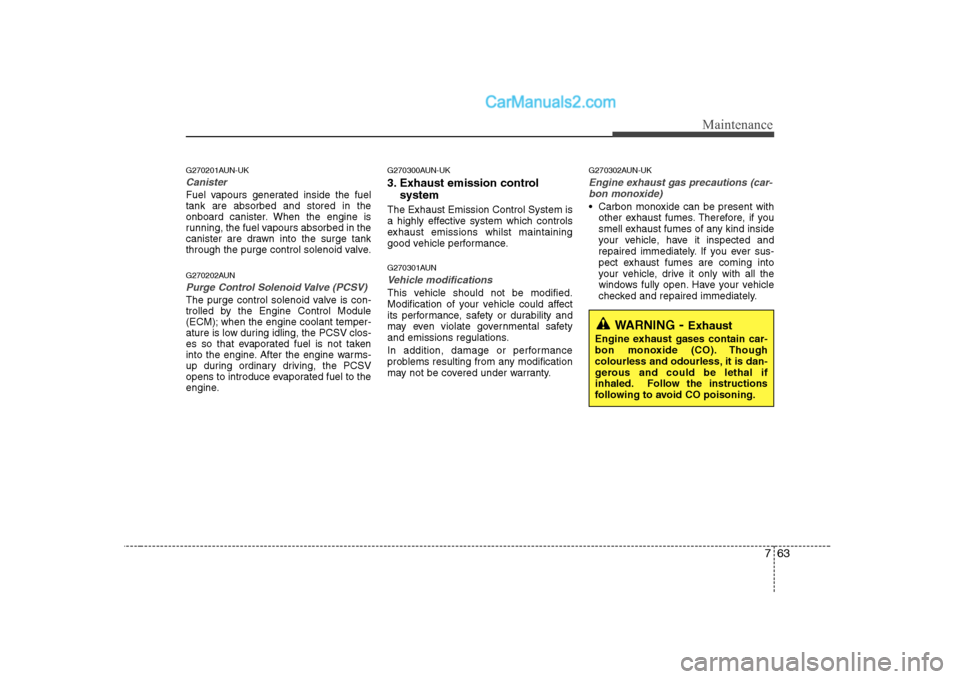
763
Maintenance
G270201AUN-UK
Canister
Fuel vapours generated inside the fuel tank are absorbed and stored in the
onboard canister. When the engine is
running, the fuel vapours absorbed in the
canister are drawn into the surge tank
through the purge control solenoid valve.
G270202AUN
Purge Control Solenoid Valve (PCSV)
The purge control solenoid valve is con-
trolled by the Engine Control Module
(ECM); when the engine coolant temper-
ature is low during idling, the PCSV clos-
es so that evaporated fuel is not taken
into the engine. After the engine warms-
up during ordinary driving, the PCSV
opens to introduce evaporated fuel to the
engine.G270300AUN-UK
3. Exhaust emission control
system
The Exhaust Emission Control System is
a highly effective system which controls
exhaust emissions whilst maintaining
good vehicle performance.
G270301AUN
Vehicle modifications
This vehicle should not be modified.
Modification of your vehicle could affect
its performance, safety or durability and
may even violate governmental safety
and emissions regulations.
In addition, damage or performance
problems resulting from any modification
may not be covered under warranty. G270302AUN-UK
Engine exhaust gas precautions (car-
bon monoxide)
Carbon monoxide can be present with other exhaust fumes. Therefore, if you
smell exhaust fumes of any kind inside
your vehicle, have it inspected and
repaired immediately. If you ever sus-
pect exhaust fumes are coming into
your vehicle, drive it only with all the
windows fully open. Have your vehicle
checked and repaired immediately.
WARNING - Exhaust
Engine exhaust gases contain car-
bon monoxide (CO). Though
colourless and odourless, it is dan-
gerous and could be lethal if
inhaled. Follow the instructions
following to avoid CO poisoning.
Page 283 of 303
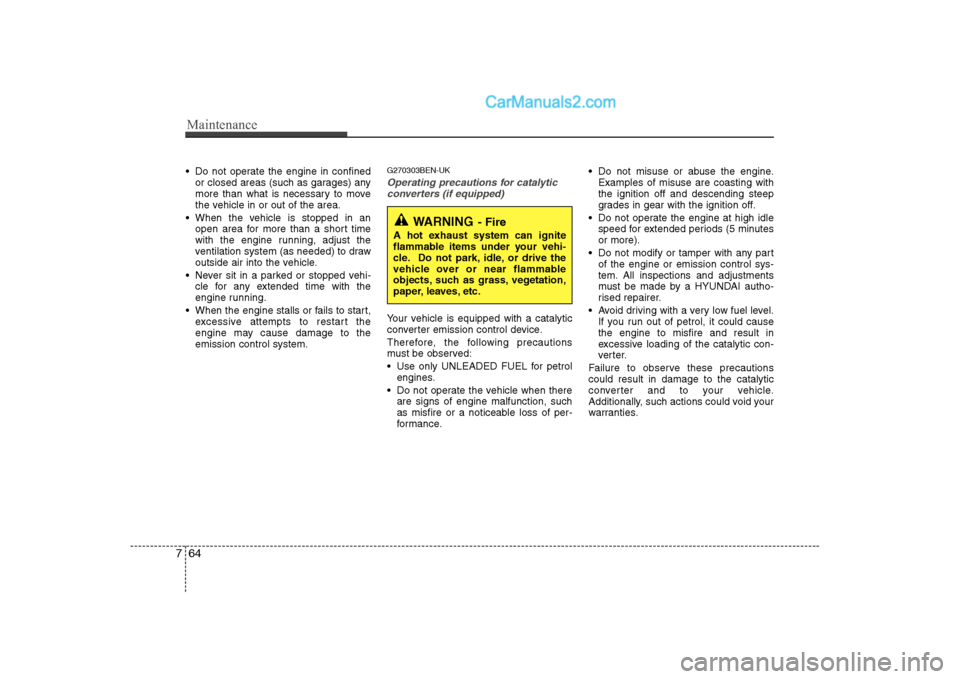
Maintenance
64
7
Do not operate the engine in confined
or closed areas (such as garages) any
more than what is necessary to move
the vehicle in or out of the area.
When the vehicle is stopped in an open area for more than a short time
with the engine running, adjust the
ventilation system (as needed) to draw
outside air into the vehicle.
Never sit in a parked or stopped vehi- cle for any extended time with the
engine running.
When the engine stalls or fails to start, excessive attempts to restart the
engine may cause damage to theemission control system. G270303BEN-UKOperating precautions for catalytic
converters (if equipped)
Your vehicle is equipped with a catalytic
converter emission control device.
Therefore, the following precautions
must be observed:
Use only UNLEADED FUEL for petrol engines.
Do not operate the vehicle when there are signs of engine malfunction, such
as misfire or a noticeable loss of per-
formance. Do not misuse or abuse the engine.
Examples of misuse are coasting withthe ignition off and descending steep
grades in gear with the ignition off.
Do not operate the engine at high idle speed for extended periods (5 minutesor more).
Do not modify or tamper with any part of the engine or emission control sys-
tem. All inspections and adjustments
must be made by a HYUNDAI autho-
rised repairer.
Avoid driving with a very low fuel level. If you run out of petrol, it could causethe engine to misfire and result in
excessive loading of the catalytic con-
verter.
Failure to observe these precautionscould result in damage to the catalytic
converter and to your vehicle.
Additionally, such actions could void your
warranties.
WARNING - Fire
A hot exhaust system can ignite
flammable items under your vehi-
cle. Do not park, idle, or drive the
vehicle over or near flammable
objects, such as grass, vegetation,
paper, leaves, etc.
Page 284 of 303

8
Vehicle identification number (VIN) / 8-2
Vehicle certification label / 8-2
Tyre specification and pressure label / 8-3
Engine number / 8-3
Consumer information
Page 285 of 303
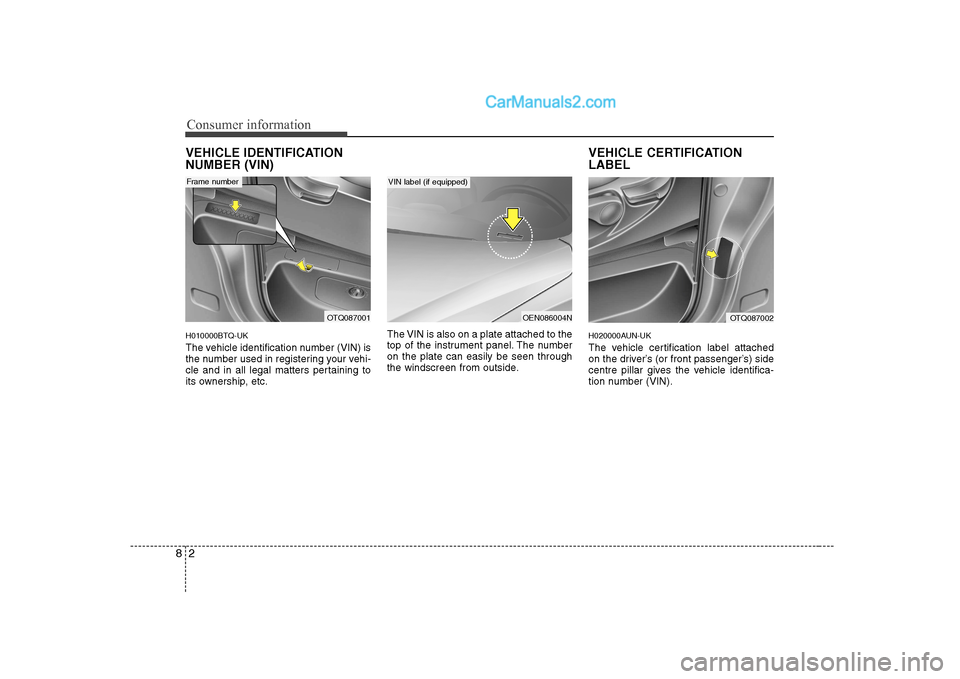
Consumer information
2
8
VEHICLE IDENTIFICATION NUMBER (VIN) H010000BTQ-UK
The vehicle identification number (VIN) is
the number used in registering your vehi-
cle and in all legal matters pertaining to
its ownership, etc. The VIN is also on a plate attached to the
top of the instrument panel. The numberon the plate can easily be seen through
the windscreen from outside.VEHICLE CERTIFICATION LABEL
H020000AUN-UK
The vehicle certification label attached
on the driver’s (or front passenger’s) side
centre pillar gives the vehicle identifica-
tion number (VIN).
OTQ087001OEN086004N
VIN label (if equipped)Frame number
OTQ087002
Page 286 of 303
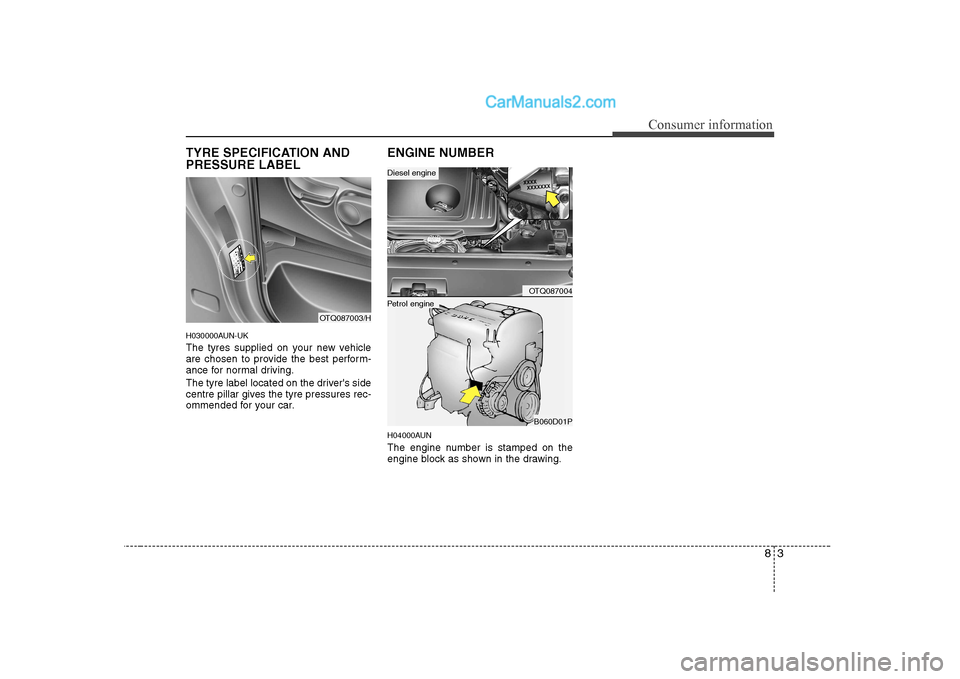
83
Consumer information
TYRE SPECIFICATION AND PRESSURE LABEL
H030000AUN-UK
The tyres supplied on your new vehicle
are chosen to provide the best perform-
ance for normal driving.
The tyre label located on the driver's side
centre pillar gives the tyre pressures rec-
ommended for your car.ENGINE NUMBER
H04000AUN
The engine number is stamped on the
engine block as shown in the drawing.
OTQ087003/H
OTQ087004
B060D01P
Petrol engine
Diesel engine
Page 287 of 303
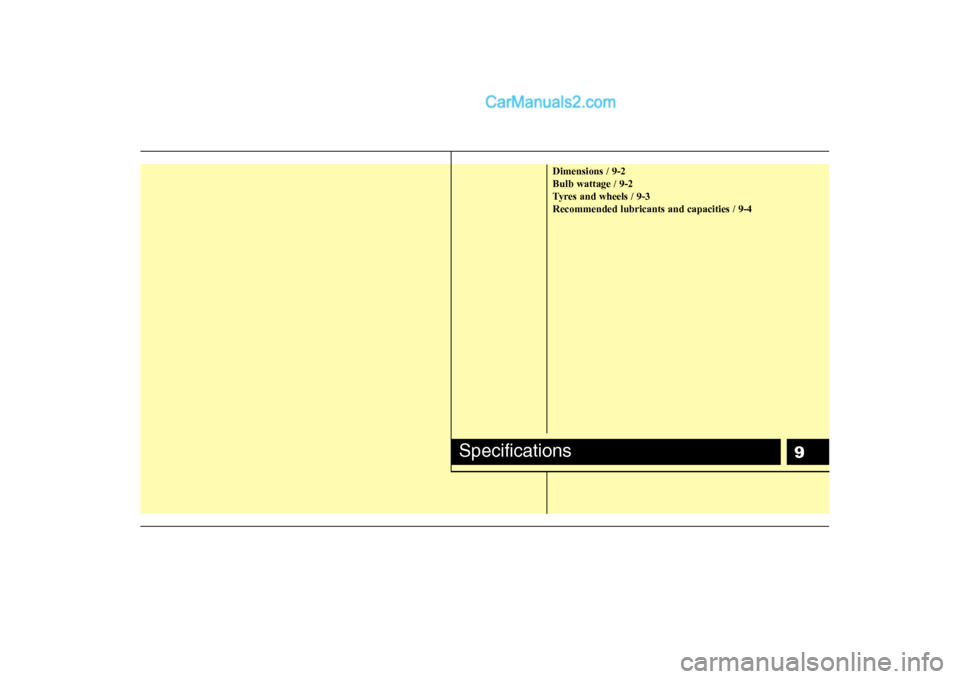
9
Dimensions / 9-2 Bulb wattage / 9-2
Tyres and wheels / 9-3Recommended lubricants and capacities / 9-4
Specifications
Page 288 of 303
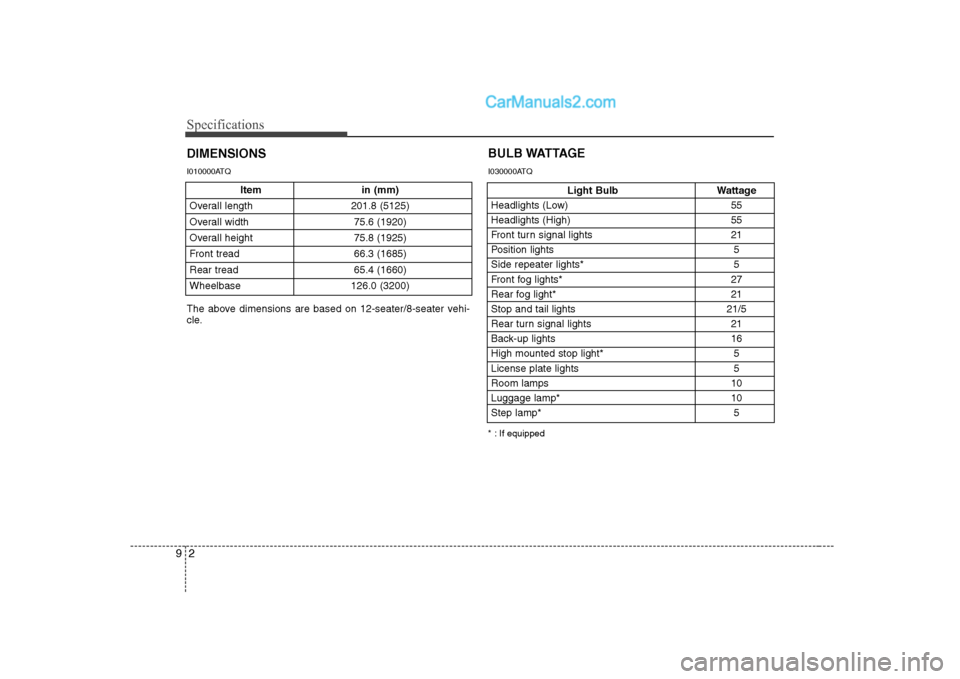
Specifications
2
9
Item in (mm)
Overall length 201.8 (5125)
Overall width 75.6 (1920)
Overall height 75.8 (1925)
Front tread 66.3 (1685)
Rear tread 65.4 (1660)
Wheelbase 126.0 (3200)
DIMENSIONS
Light Bulb Wattage
Headlights (Low) 55
Headlights (High) 55
Front turn signal lights 21
Position lights 5
Side repeater lights* 5
Front fog lights* 27
Rear fog light* 21
Stop and tail lights 21/5
Rear turn signal lights 21
Back-up lights 16
High mounted stop light* 5
License plate lights 5Room lamps 10
Luggage lamp* 10
Step lamp* 5
BULB WATTAGE
* : If equipped
The above dimensions are based on 12-seater/8-seater vehi-
cle.
I010000ATQ
I030000ATQ
Page 289 of 303
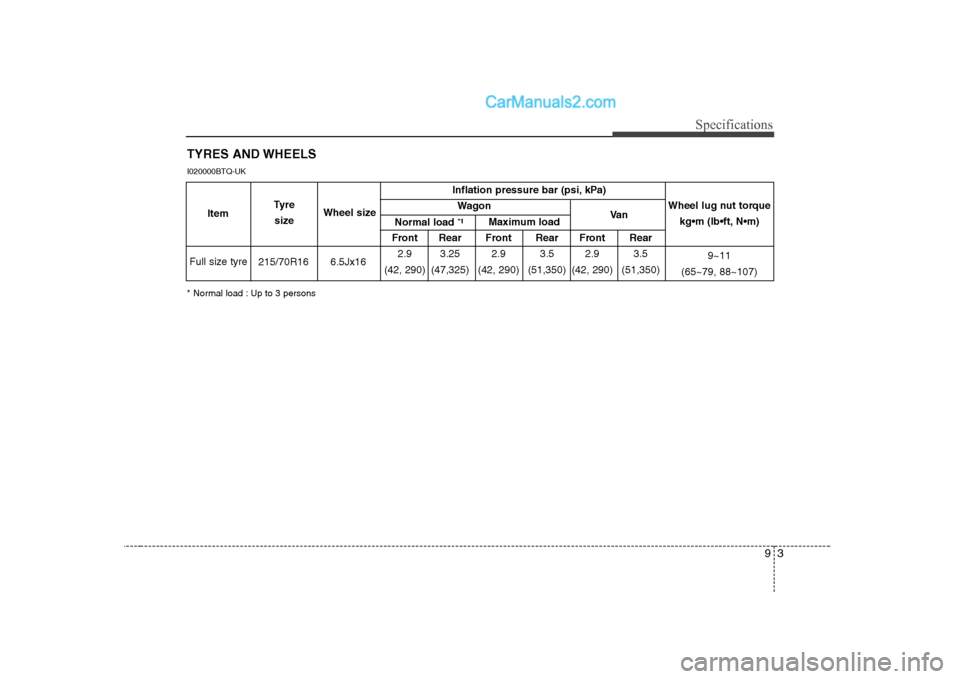
93
Specifications
TYRES AND WHEELS
* Normal load : Up to 3 persons
I020000BTQ-UK
Inflation pressure bar (psi, kPa)
Wagon
Front Rear Front Rear Front Rear
215/70R16 6.5Jx16 2.9 3.25 2.9 3.5 2.9 3.5
(42, 290) (47,325) (42, 290) (51,350) (42, 290) (51,350)
Full size tyre Wheel lug nut torque
kg•m (lb N
9~11
(65~79, 88~107)
Item
Tyre
size Wheel size
Normal load *1
Maximum load Va n
Page 290 of 303
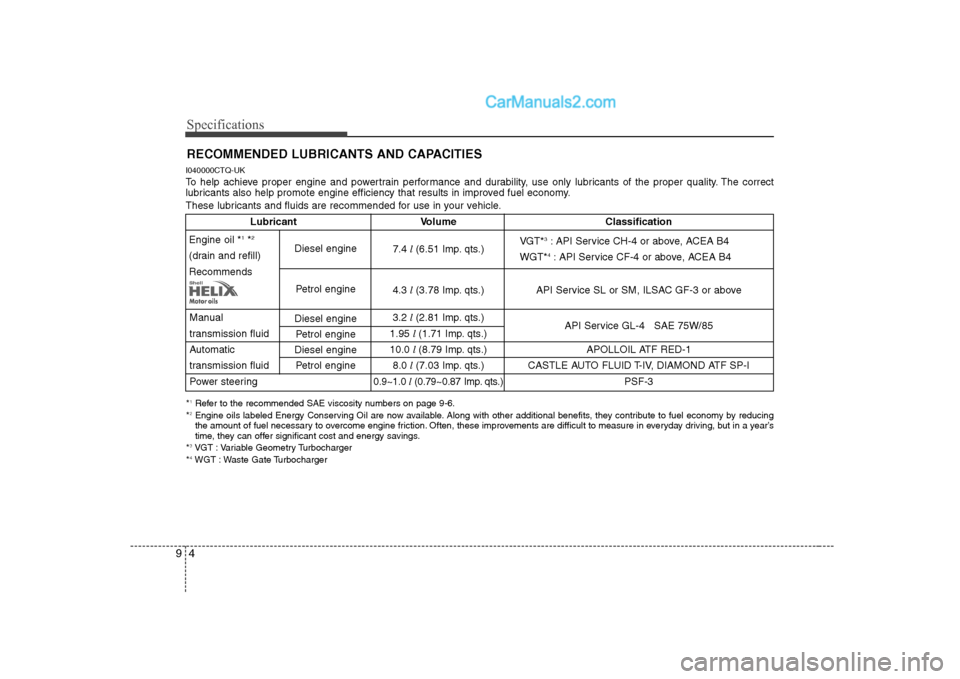
Specifications
4
9
RECOMMENDED LUBRICANTS AND CAPACITIES
I040000CTQ-UK
To help achieve proper engine and powertrain performance and durability, use only lubricants of the proper quality. The correct
lubricants also help promote engine efficiency that results in improved fuel economy.
These lubricants and fluids are recommended for use in your vehicle.
* 1
Refer to the recommended SAE viscosity numbers on page 9-6.
* 2
Engine oils labeled Energy Conserving Oil are now available. Along with other additional benefits, they contribute to fuel econo my by reducing
the amount of fuel necessary to overcome engine friction. Often, these improvements are difficult to measure in everyday driving, but in a year’s
time, they can offer significant cost and energy savings.
* 3
VGT : Variable Geometry Turbocharger
* 4
WGT : Waste Gate Turbocharger
Lubricant Volume Classification
7.4 l (6.51 Imp. qts.)
4.3 l (3.78 Imp. qts.) API Service SL or SM, ILSAC GF-3 or above
Manual 3.2 l (2.81 Imp. qts.)
API Service GL-4 SAE 75W/85
transmission fluid 1.95 l (1.71 Imp. qts.)
Automatic 10.0 l (8.79 Imp. qts.) APOLLOIL ATF RED-1
transmission fluid 8.0 l (7.03 Imp. qts.) CASTLE AUTO FLUID T-IV, DIAMOND ATF SP-I
Power steering
0.9~1.0 l (0.79~0.87 Imp. qts.)PSF-3
Engine oil * 1
*2
(drain and refill) Recommends
Diesel enginePetrol engine
Diesel engine
Petrol engine
Diesel engine
Petrol engineVGT* 3
: API Service CH-4 or above, ACEA B4
WGT* 4
: API Service CF-4 or above, ACEA B4